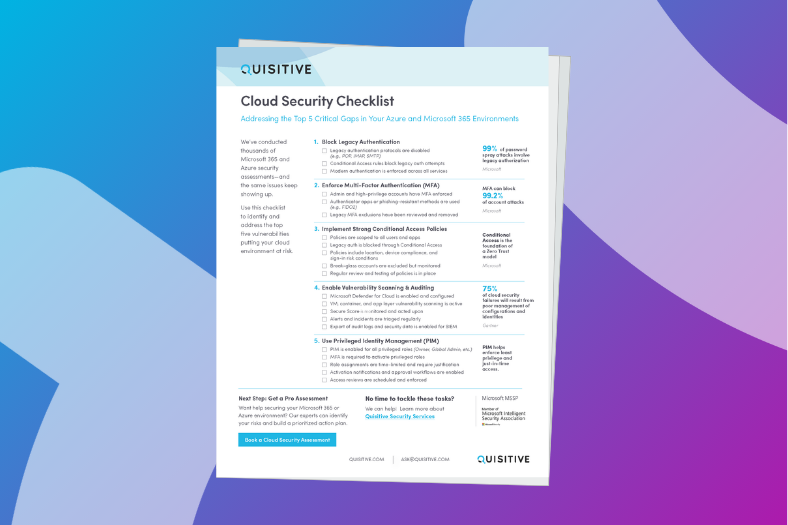As a Microsoft Managed Security Services Provider (MSSP) and proud member of the Microsoft Intelligent Security Association (MISA), we’ve conducted thousands of cloud security assessments across industries. While every organization is unique, we’ve consistently found five critical vulnerabilities in Microsoft 365 and Azure environments that leave organizations open to attack. In this blog, we’ll break down these five common security issues or gaps, explain why they matter, and provide actionable recommendations backed by real-world data.
Top 5 Cloud Security Issues Our Experts Uncover in Environment Assessments
1. Legacy Authentication Is Still Enabled and Still a Huge Risk
The problem: Legacy authentication protocols (like POP, IMAP, SMTP) are a major security risk. They don’t support modern security standards like Multi-Factor Authentication (MFA), making them a prime target for password spray and brute force attacks.
Why it matters: According to Microsoft, over 99% of password spray attacks leverage legacy protocols. Yet, we still find legacy auth enabled in most environments we assess.
What to do: Block legacy authentication using Conditional Access in Microsoft 365 and Azure AD. This simple change can shut down an entire category of identity-based attacks.
2. MFA Still Isn’t Enforced for All Users and Admins
The problem: Despite the well-known benefits of MFA, many organizations fail to enforce it broadly, especially for privileged users like global admins.
Why it matters: Microsoft reports that MFA blocks 99.2% of account compromise attacks (source). Skipping MFA on high-privilege accounts is like leaving your server room unlocked.
What to do: Require MFA for all users—starting with admins—and use modern authentication methods (Authenticator app, FIDO2, etc.) to maximize protection.
3. Conditional Access Policies Are Too Weak or Missing Entirely
The problem: Even when Conditional Access is configured, it’s often too lenient or doesn’t account for legacy protocols, allowing risky sign-ins to bypass policy controls.
Why it matters: Conditional Access is your best defense against modern identity threats. Without properly scoped rules, you can’t enforce Zero Trust principles like device compliance, location-based access, or session controls.
What to do: Design and implement Conditional Access policies that:
- Require MFA for all users
- Block legacy authentication
- Restrict access by device or location
- Apply user risk and sign-in risk conditions
Learn more in Microsoft’s official Conditional Access documentation.
4. Inconsistent or Missing Vulnerability Scanning and Auditing
The problem: Many Azure environments lack consistent vulnerability management practices. We often see no scanning at the VM or container level, limited use of Microsoft Defender for Cloud, and critical alerts left unresolved.
Why it matters: Without visibility into vulnerabilities, organizations are flying blind. Gartner estimates that 75% of security failures in the cloud will result from inadequate management of identities, access, and configurations through 2025 (source).
What to do: Enable Microsoft Defender for Cloud, configure continuous export of security findings, and regularly review Secure Score to prioritize remediations.
5. Privileged Identity Management (PIM) Isn’t Deployed or Properly Configured
The problem: Azure Privileged Identity Management (PIM) is often underused, especially for high-risk roles like subscription owner, global admin, or security admin.
Why it matters: PIM enforces just-in-time access and approval workflows, drastically reducing the attack surface for privileged accounts. Without it, attackers who gain access to one high-privilege account can wreak havoc.
What to do: Implement PIM for all privileged roles, enforce MFA for activation, and monitor access logs regularly. Microsoft’s best practices for PIM offer a great starting point.
How well does your organization score on the Cloud Security Checklist?
Don’t let your organization fall victim to these common cloud security issues. Use this cloud security checklist to identify and address the top five vulnerabilities that put your cloud environment at risk.
Taking the Next Steps in Improving Your Cloud Security Posture
These five cloud security issues show up again and again in our security assessments—and all five are fixable with native Microsoft tools. Addressing them is one of the fastest ways to reduce risk and strengthen your cloud security posture.
At Quisitive, we specialize in helping organizations secure their Microsoft 365 and Azure environments with actionable guidance, automation, and 24/7 managed services. If you’re ready to identify and fix gaps in your cloud security strategy, let’s talk or to learn which vulnerabilities are lurking in your environments, book a cloud security assessment today.

;)




